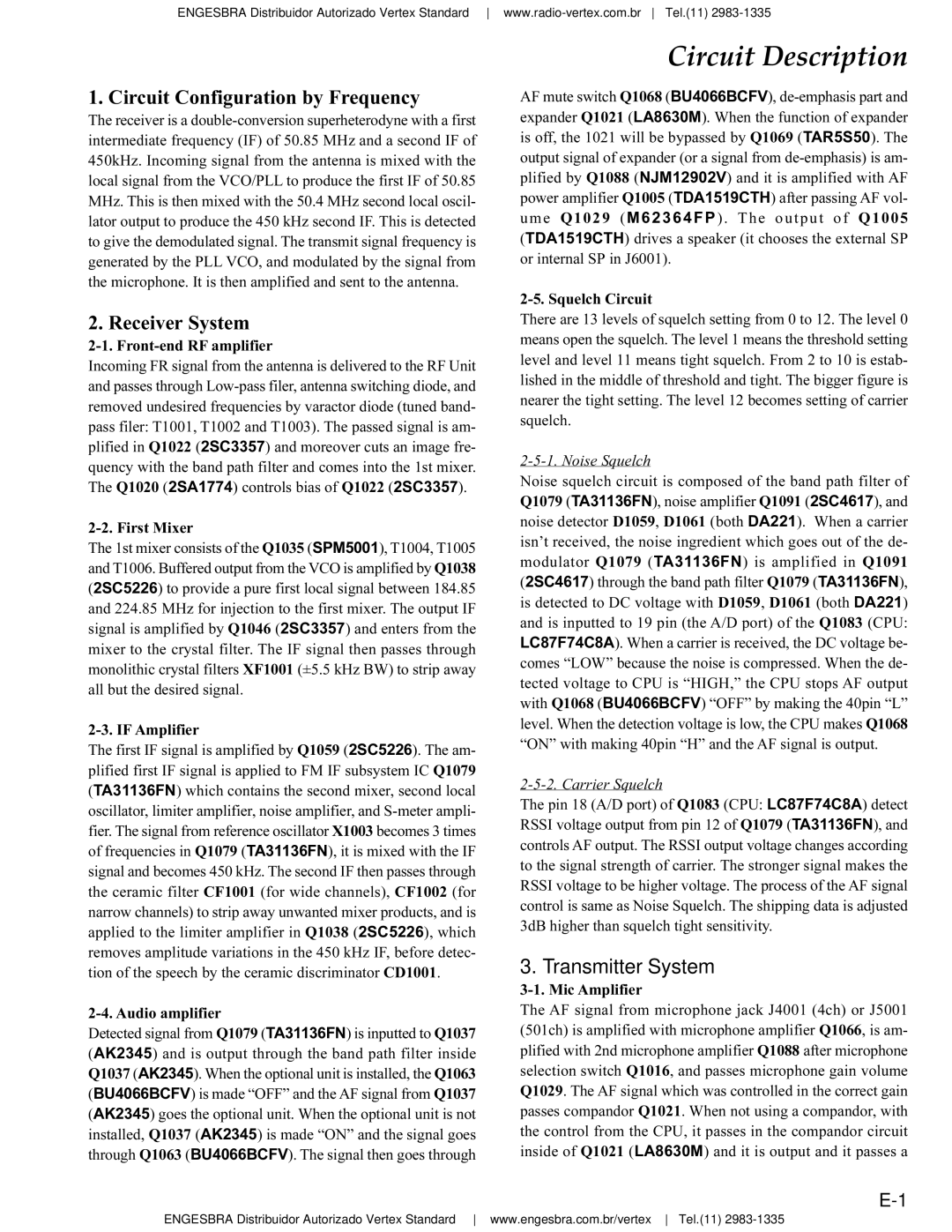ENGESBRA Distribuidor Autorizado Vertex Standard
1. Circuit Configuration by Frequency
The receiver is a
2. Receiver System
2-1. Front-end RF amplifier
Incoming FR signal from the antenna is delivered to the RF Unit and passes through
The 1st mixer consists of the Q1035 (SPM5001), T1004, T1005 and T1006. Buffered output from the VCO is amplified by Q1038 (2SC5226) to provide a pure first local signal between 184.85 and 224.85 MHz for injection to the first mixer. The output IF signal is amplified by Q1046 (2SC3357) and enters from the mixer to the crystal filter. The IF signal then passes through monolithic crystal filters XF1001 (±5.5 kHz BW) to strip away all but the desired signal.
The first IF signal is amplified by Q1059 (2SC5226). The am- plified first IF signal is applied to FM IF subsystem IC Q1079 (TA31136FN) which contains the second mixer, second local oscillator, limiter amplifier, noise amplifier, and
Detected signal from Q1079 (TA31136FN) is inputted to Q1037 (AK2345) and is output through the band path filter inside Q1037 (AK2345). When the optional unit is installed, the Q1063 (BU4066BCFV) is made “OFF” and the AF signal from Q1037 (AK2345) goes the optional unit. When the optional unit is not installed, Q1037 (AK2345) is made “ON” and the signal goes through Q1063 (BU4066BCFV). The signal then goes through
Circuit Description
AF mute switch Q1068 (BU4066BCFV),
There are 13 levels of squelch setting from 0 to 12. The level 0 means open the squelch. The level 1 means the threshold setting level and level 11 means tight squelch. From 2 to 10 is estab- lished in the middle of threshold and tight. The bigger figure is nearer the tight setting. The level 12 becomes setting of carrier squelch.
Noise squelch circuit is composed of the band path filter of Q1079 (TA31136FN), noise amplifier Q1091 (2SC4617), and noise detector D1059, D1061 (both DA221). When a carrier isn’t received, the noise ingredient which goes out of the de- modulator Q1079 (TA31136FN) is amplified in Q1091 (2SC4617) through the band path filter Q1079 (TA31136FN), is detected to DC voltage with D1059, D1061 (both DA221) and is inputted to 19 pin (the A/D port) of the Q1083 (CPU: LC87F74C8A). When a carrier is received, the DC voltage be- comes “LOW” because the noise is compressed. When the de- tected voltage to CPU is “HIGH,” the CPU stops AF output with Q1068 (BU4066BCFV) “OFF” by making the 40pin “L” level. When the detection voltage is low, the CPU makes Q1068 “ON” with making 40pin “H” and the AF signal is output.
The pin 18 (A/D port) of Q1083 (CPU: LC87F74C8A) detect RSSI voltage output from pin 12 of Q1079 (TA31136FN), and controls AF output. The RSSI output voltage changes according to the signal strength of carrier. The stronger signal makes the RSSI voltage to be higher voltage. The process of the AF signal control is same as Noise Squelch. The shipping data is adjusted 3dB higher than squelch tight sensitivity.
3. Transmitter System
The AF signal from microphone jack J4001 (4ch) or J5001 (501ch) is amplified with microphone amplifier Q1066, is am- plified with 2nd microphone amplifier Q1088 after microphone selection switch Q1016, and passes microphone gain volume Q1029. The AF signal which was controlled in the correct gain passes compandor Q1021. When not using a compandor, with the control from the CPU, it passes in the compandor circuit inside of Q1021 (LA8630M) and it is output and it passes a
ENGESBRA Distribuidor Autorizado Vertex Standard www.engesbra.com.br/vertex Tel.(11)
